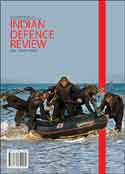The Army has over a period of time evolved a comprehensive and well thought out methodology to effectively manage its Human Capital.
The spectrum of conflict for which the Army needs to be prepared for and the demands of the future battle field environment on the human resources element necessitate that the soldiers inducted into the Army be qualitatively superior to what was expected earlier. Some of the characteristics that are vital for soldiers of the future are as under:-
- Quick decision making capability, greater mental mobility and ability to adapt to rapidly changing situations.
- Capacity to handle higher stress levels.
- Capability to handle independent assignments.
- Higher technical competence.
- Greater motivational levels and higher standards of junior leadership.
- Better administrative skills.
- The paradigm shift in the ‘quality of intake required for the Army, both at the officers’ level and for JCOs/OR warrants that adequate incentives be made available to attract the right material, motivate them to join the services and thereafter retain them in service.14 The present day youth look for improved quality of life, better pay and perks, assured career progression, appropriate educational and housing facilities, good medical backup, equitable status with their civilian counterparts and better post retirement benefits. The demands on the organization are thus immense. The magnitude and scope of the task, given the size of the Army, is extremely large, complex and diverse as it involves every individual in the Army, right from the time he or she is inducted into the organization, with the bonding continuing even after their retirement and demise.
All major issues handled by the Army are based on vision documents which lay down time frames for their conceptualization and implementation”¦ Each task is thereafter broken down into short, medium and long term objectives and time frames laid down for accomplishment of each phase.
The Army has over a period of time evolved a comprehensive and well thought out methodology to effectively manage its Human Capital. In order to ensure that the thought process remains current and relevant, it is subjected to regular scrutiny and refinement. Transparent policies, correct selection systems, appropriate training and development methods, objective appraisal systems, dynamic leadership styles with the right organizational climate and effective post service management, all of which are critical imperatives for growth and development of any organization, form the bedrock on which the strategy is based. Some of the factors that lend credence to the strategy are :-
- Perspective Planning. Adequate care is taken to ensure that the futuristic manpower requirements of the Army, up to a time frame of 2022, have been factored in while working out the staffing levels.15 The endeavour is to plan as far forward as possible. Adequate care is also taken to ensure that inductions being made are done after careful evaluation and assessment of wastage rates likely to take place in the future.
- Structured Approach. Since the policies dealt with have far reaching implications and remain in vogue for protracted periods of time, the same are evolved after due deliberation, following a structured approach. Each issue is tackled at three levels- the strategic, operational and functional level. Also, in order to ensure that the issues are progressed in a systematic manner, they are dealt with separately for the three distinct categories of human resources that the Army has to contend with-the fresh inductees both officers and JCOs/OR, those already in service and those who have retired from service.
- Clear Road Map. All major issues handled by the Army are based on vision documents which lay down time frames for their conceptualization and implementation. The vision is laid down at the strategic or apex level and is then disseminated down for execution and implementation to the operational and functional levels respectively. Each task is thereafter broken down into short, medium and long term objectives and time frames laid down for accomplishment of each phase.
- Feedback Mechanism. In order to ensure that matters affecting policy have wide acceptance, they are invariably put through intense scrutiny and are formalized only after obtaining a comprehensive feedback from the environment. Changes, amendments and modifications are, thereafter, made to the directives to make them as comprehensive as feasible.
- Periodic Review. All issues related to human capital development and management are subjected to periodic reviews so as to take corrective measures and institute mid-course corrections as and when required.
 Ensuring the right manning levels, providing all ranks attractive and acceptable terms of engagement, creating appropriate service conditions and ensuring satisfactory post retirement benefits are some of the means that have been adopted to effectively manage the human capital in the Army.
Ensuring the right manning levels, providing all ranks attractive and acceptable terms of engagement, creating appropriate service conditions and ensuring satisfactory post retirement benefits are some of the means that have been adopted to effectively manage the human capital in the Army.





Dear Mukesh !!!
I feel that you are the same Mukesh, I knew 45 years ago as younger brother of Rakesh, my class mate in B.Sc. at Jodhpur. At that time your father was custom collector at Jodhpur. If that is true, please contact me at e mail pareekrg@gmail.com or phone 01334231144 and 09897107945. Thank you and with best wishes
Ram Gopal Pareek, Haridwar